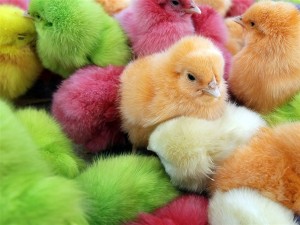Easter is a big deal in some places, what with the chicks, the bunnies, the chocolate and other religious artifacts to commemorate the resurrection of spring – in the North.
In the South – Australia, not Alabama – Easter marks the beginning of fall, and the kids get two weeks off school.
In the lead-up to Easter, there are some questionable activities that may be going on at day cares and schools (have I mentioned the other parents hate  me?) or in your own kitchen.
me?) or in your own kitchen.
A reader sent in this bit from Flower Factor:
“Easter is early this year, falling on Sunday, March 31. I’ve been saving eggshells since January. Quick tip on eggshells: Rather than break the egg in half, carefully tap the top and pour out the egg for use in cooking. Then, carefully, rinse the shell and let it dry. This is ‘re-use and recycle’ at its finest. If you want to make your florist love you, take them cleaned eggs for designing — there are only so many eggs we can eat! And we florists will take your egg trays, too.”
And fill them with jelly beans.
Cardboard egg cartons are impossible to clean; eggs have a tendency to transmit Salmonella; putting ready-to-eat jelly beans in such a container is food porn not food safety.
Chicks in day cares? Great educational opportunity – and they’re cute. But as one teacher was telling me, she has to keep the kids outside or be watching all the time, because 4-year-olds do the most unexpected things: like lick the cage, or stick their hands in chicken poop, or open the crate and smash a chick against a wall (that kid needs help).
The U.S. Centers for Disease Control reiterated today that 195 people – mainly kids – in 27 states were sickened with Salmonella from March 1–September 24, 2012, after exposure to chicks from a single mail-order hatchery.
This outbreak investigation identified the largest number of human illnesses ever linked to contact with live poultry during a single outbreak, and it  underscores the ongoing risk for human salmonellosis linked to backyard flocks. Preventing live poultry–associated salmonellosis requires an integrated approach involving mail-order hatcheries, agricultural feed stores, and consumers. Mail-order hatcheries should comply with management and sanitation practices outlined by USDA-NPIP and avoid the shipment of day-old chicks through their hatchery from another hatchery (e.g., trans-shipping). Feed stores should use physical barriers (e.g., a wall or fence) between customers and poultry displays to prevent direct contact with poultry. Educational materials warning customers and advising them on how to reduce the risk for Salmonella infection from live poultry should be distributed with all live poultry purchases.
underscores the ongoing risk for human salmonellosis linked to backyard flocks. Preventing live poultry–associated salmonellosis requires an integrated approach involving mail-order hatcheries, agricultural feed stores, and consumers. Mail-order hatcheries should comply with management and sanitation practices outlined by USDA-NPIP and avoid the shipment of day-old chicks through their hatchery from another hatchery (e.g., trans-shipping). Feed stores should use physical barriers (e.g., a wall or fence) between customers and poultry displays to prevent direct contact with poultry. Educational materials warning customers and advising them on how to reduce the risk for Salmonella infection from live poultry should be distributed with all live poultry purchases.
You see something cute, I see a Salmonella factory.
